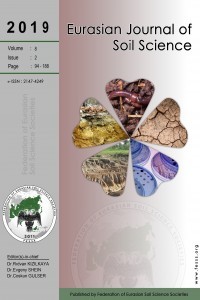
Eurasian Journal of Soil Science
Yazarlar: Martin REİSS, Peter CHİFFLARD
Konular:-
DOI:10.18393/ejss.2015.3.169-177
Anahtar Kelimeler:Pedohydrology,Trace elements,Periglacial cover beds,Hillslope hydrology,Geochemical barriers
Özet: Periglacial cover beds are an important trigger of slope-water paths in sloped terrain of the mid-latitudes. Most hydropedological studies focus on the quantitative analysis about the interrelation between subsurface layering and runoff processes at the slope scale. In this research we emphasis on a qualitative environmental geochemical analysis of trace elements and dissolved organic carbon in a small forest hydrological study area in the central parts of the subdued mountains of Germany (Location: KrofdorferForst, +50° 41' 3.69", +8° 38' 38.87"). The main objective is to assess the effect of lithological discontinuities of stratified soils within the depth functions of trace elements concentration in soil solutions (soil water and its dissolved and mobile fraction in a vertical distribution). Lorz (2008) show that depth functions of manganese (Mn) are characterized by strong pedogenic dynamics, analysing a shortened sequential extraction of solid soil material. We investigated the hypothesis that lithological discontinuities act like aquicludes. Therefore we expect abrupt changes within the depth function of manganese as a result of such water-blocking effect (= geochemical barriers) as a consequence of mobilization under wet soil conditions. In a preliminary case study we sampled soil solutions from three different plots within a 400m-toposequence. We use in situ trench installed suction lysimeters with ceramic tips (Irrometer Soil Solution Access Tube) to extract soil water samples each 20 cm from top- (10 cm) to subsoil (110 cm). For geochemical element analysis we use an inductively coupled plasma mass spectrometry (ICP-MS). The results: A clear character of abrupt changes within the depth function could be illustrated for most of the plots. For example, at the upper slope plot a contrast of the depth function is from 1013 ppb mean concentration at 50 cm profile depth to 290 ppb mean concentration at 70 cm profile depth (17 month sampling period). To conclude, these results demonstrate that hydrochemical quality and translocation processes of soil solutions determining an interrelation between subsurface layering and run off processes - respectively could be seen as an environmental consequence of it.